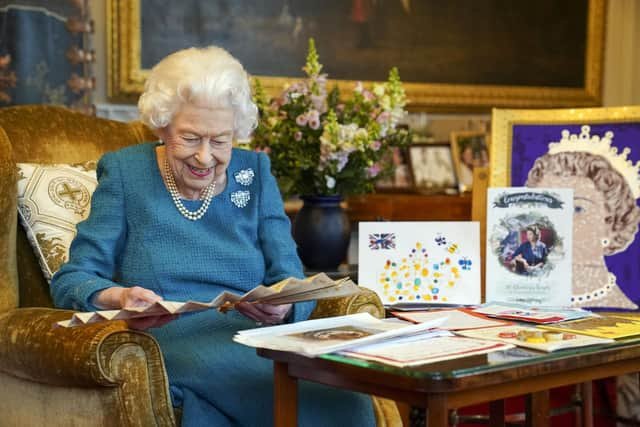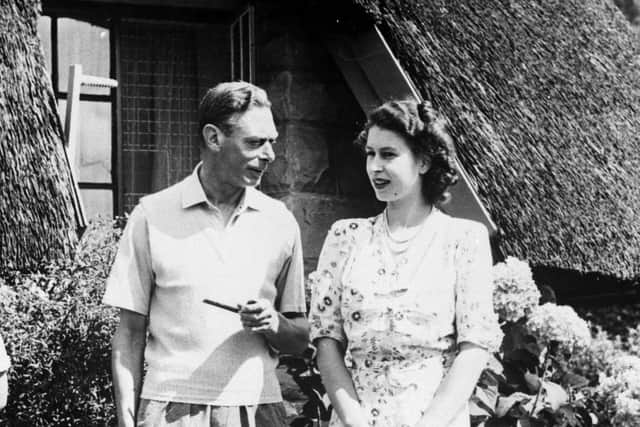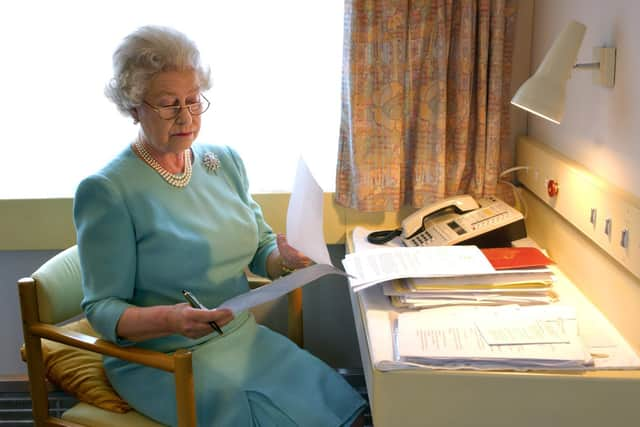The heartbreaking tale of how The Queen found out she would take over the throne
There was still an enchanting and endearing innocence to Princess Elizabeth on the landmark day that she became Queen 70 years ago this weekend after the unexpected death of her father King George VI in his sleep at Sandringham.
She woke on February 6, 1952, as a princess at the iconic Treetops hotel in the foothills of Mount Kenya as she undertook a Commonwealth tour in place of her parents while the King recuperated from the removal of a lung and the strain that the Second World War had placed on his health made more fragile by his fondness for tobacco. He was only 56 years of age.
Advertisement
Hide AdAdvertisement
Hide AdBy mid-afternoon, the dashing 25-year-old princess had become Queen – without realising that she already had the weight of the monarchy on her fragile shoulders – because communication between Britain and Africa was still primitive.


And here’s the poignancy. After lunch, she wrote a tender letter to her father, telling him of her hope that he, too, would be able to visit Kenya in time, while Prince Philip read the papers and dozed peacefully on their bed.
Yet, unbeknownst to a royal party which included Lady Pamela Mountbatten, Princess Elizabeth’s lady-in-waiting, and Commander Mike Parker, Prince Philip’s private secretary, the King had already been discovered dead by his valet.
Using the established code word ‘Hyde Park’, His Majesty’s principal private secretary called an assistant in London to instruct them to inform Winston Churchill, the Prime Minister, and Queen Mary, the King’s mother, ahead of a 10.45am public announcement.


Advertisement
Hide AdAdvertisement
Hide AdHowever the three hour time difference meant the tragic news did not reach Kenya until 1.45pm just as the travelling royals finished lunch and Princess Elizabeth started writing a last letter that her father would never see.
The historic moment that a princess learned that she had become a Queen, ironically in “the happy paradise of a demi-Eden”, was witnessed by Lady Pamela, the daughter of Lord Mountbatten of Burma, chronicled for posterity and recently republished A Queen For All Seasons by TV personality Joanna Lumley to celebrate the Platinum Jubilee.
“There was a portable wireless in the sitting room where Princess Elizabeth was writing and Mike (Parker) crept in, managing to get it without her noticing,” Lady Pamela wrote.
“After a few minutes of static and frantic tuning, we finally made out the faint sound of solemn music with which the BBC had replaced all its programmes.


Advertisement
Hide AdAdvertisement
Hide Ad“After the tolling of Big Ben, the news at last reached us from far away, the gravity of the newsreader’s tone unmistakable.”
She went on to describe how Commander Parker went straight to tell Prince Philip who “lifted up his newspaper to cover his face in a gesture of despair” before lamenting “this will be such a blow”.
“He (Prince Philip) then walked into his sitting room and asked his wife to come with him into the garden,” added Lady Pamela. “Mike and I watched them on the lawn as they walked together slowly, up and down, up and down.”
And then a long, and lonely, journey home to begin a reign unprecedented in the Royal family’s history and which will culminate in this year’s Platinum Jubilee celebrations.
Advertisement
Hide AdAdvertisement
Hide AdPrincess Elizabeth was not destined to become Queen when she was born in 1926. Yet, while a lifetime of service was expected, her future destiny as a monarch only became clear a decade later when her uncle, King Edward VIII, renounced the throne in the 1936 abdication crisis to pursue his romance with the American socialite Wallis Simpson.
And while she was carefully nurtured by her parents, especially through the war years, for the inevitable day when she would become Queen, another Royal letter reveals the shock caused by the suddenness of the King’s death.
It was sent to the late King’s mother, Queen Mary, by his widow Queen Elizabeth before she became universally known, with longlasting affection, as the Queen Mother.
The letter began affectionately ‘My Darling Mama’ and continued: “What can I say to you – I know that you loved Bertie clearly, and he was my whole life, and one can only be deeply thankful for the utterly happy years we had together.”
Advertisement
Hide AdAdvertisement
Hide AdShe went on: “It is impossible for me to grasp what has happened, last night he was in wonderful form and looking so well, and this morning, only a few hours ago, I was sent a message that his servant couldn’t waken him.
“I flew to his room & thought that he was in a deep sleep, he looked so peaceful – and then I realised what had happened.
“It is hard to grasp, he was such an angel to the children, and I cannot bear to think of Lilibet, so young to bear such a burden.” The letter ended ‘Your very loving Elizabeth’.”
This private grief also helps to explain why the Queen traditionally marks the anniversary of her father’s death, and her accession to the throne, at Sandringham and, invariably, in quiet reflection away from the public gaze.
Advertisement
Hide AdAdvertisement
Hide AdToday's landmark day, however, takes on added significance because of the historical landmark and the absence of Prince Philip, her husband of 73 years, who died last April and was invariably at his happiest when relaxing at the Royal family’s Norfolk estate and pursuing country sports.
And this is precisely what his father-in-law – the late King – had been doing according to a front page report in The Yorkshire Post on February 7, 1952, under the headline ‘New Queen To Be Proclaimed Today’.
It reported that the proclamation of the accession of the new Queen had already taken place at St James’s Palace by 150 members of the Privy Council – Elizabeth and Philip were, by now, no the way back to Britain – before Lord Fermoy offered details about a shooting expedition with the King on the day before his death.
He said: “The King, a great shot, was yesterday on top of his form. I saw him get nine hares and one pigeon, which he took perfectly cleanly 80 to 100 feet up. It was a lovely day, the King was perfectly happy.”
Advertisement
Hide AdAdvertisement
Hide AdLord Fermoy said the parting words of His Royal Highness were these: “I shall expect you here at 9am on Thursday.”
As Parliament was adjourned and flags lowered to half-mast, the cause of the King’s death was the subject of intense front-page speculation by this newspaper’s medical correspondent while President Truman was amongst the first world leaders to offer condolences.
Speaking from the White House, he acknowledged the King’s stoicism during the war before saying: “His heroic endurance of pain and suffering during these past few years is a true reflection of the bravery of British people in adversity.
“The King was ever conscious of his obligations as Sovereign of a nation which through centuries has been the champion of personal liberty and those free institutions which ruthless dictators despise.”
Advertisement
Hide AdAdvertisement
Hide AdMeanwhile a separate story reported that the new Queen and Prince Philip had left Nanyuki Airport and, in an indication of the protocol’s formality, “the crew of the aircraft were presented before the take-off”.
The new Queen Elizabeth, this newspaper reported, was wearing a beige dress with accessories while Prince Philip wore a grey suit and black tie.
A member of the Royal household told how Elizabeth had reacted to news of her father’s death: “She took it very bravely – like a Queen.”
According to broadcaster Andrew Marr’s book The Diamond Queen that was published a decade ago to mark the 60th anniversary of the Queen’s reign, Lady Pamela, whose father Lord Mountbatten of Burma was killed by IRA terrorists in 1979, described how the new monarch was more concerned about the wellbeing of others rather than the lifetime of devoted duty that lay ahead.
Advertisement
Hide AdAdvertisement
Hide Ad“In her usual extraordinary way...she was thinking about what everybody else was having to do. Typically, she said: “Oh, thank you. But I am sorry it means we have to go back to England and it’s upsetting everybody’s plans.”
There were two footnotes at the bottom of this newspaper’s front page – one reported “at 3am the Queen’s ‘plane was 325 miles south-west of Wadi Halfa (Sudan), having then covered 1,434 miles” – and that Winston Churchill would address the nation that evening.
He would describe how the King was “greatly loved by all his peoples” before, with customary oratory, exhorting the “gifts” of a new Queen who “did not pass her childhood in any certain expectation of the Crown”. Mr Churchill ended his heartfelt speech by “invoking once more the prayer and the anthem, God Save The Queen. ”